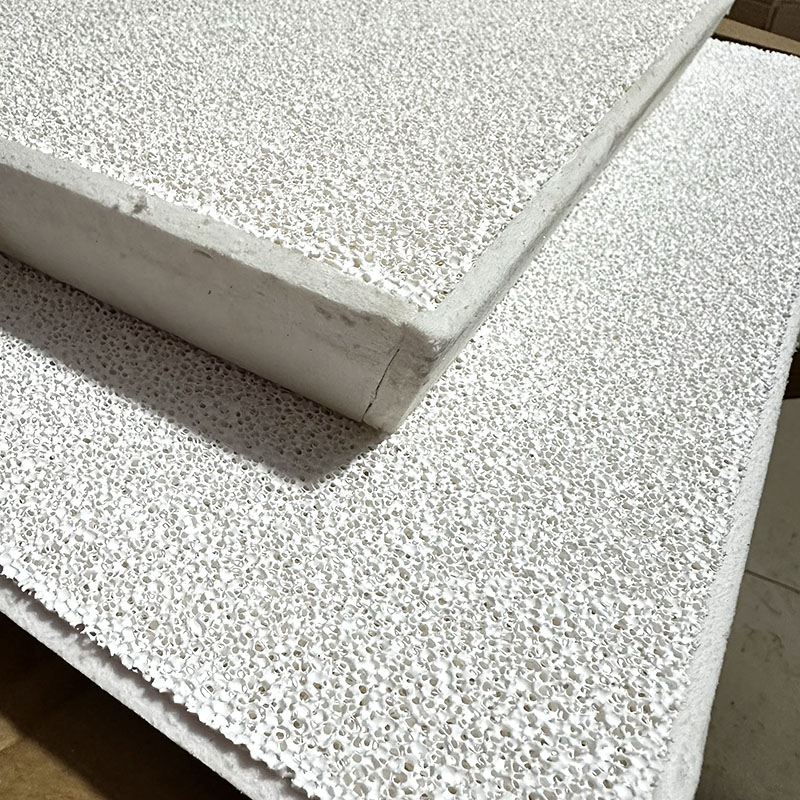+86 13705336167
+86 13705336167
The feature effectively eliminates large impurities in molten aluminum and adsorbs micro-sized particles of small impurities, thereby enhancing surface quality, improving product performance, optimizing microstructure, and ultimately increasing yield. It finds extensive applications in the production fields of aluminum profiles, aluminum foil, aluminum alloys, etc
Specifications And Models

The term 'P' is widely used in this standard to indicate the product model, where the preceding number represents the pore density and corresponds to its uniformity. For example, a model labeled as '10P' represents a foam ceramic filtration product that has a range of pore uniformity from 7 to 13 pores per 25.4mm length.
Regular Size mm(inch) | Range of aluminum liquid flow kg/min | Filtering Quantity T | Aperture(Mesh Number) PPI | |
| 305x305x50(12'') | 90-170 | 15 | 20 25 | Customized |
| 381x381x50(15'') | 147-280 | 20 | 30 35 | |
| 432x432x50(17'') | 193-367 | 25 | 40 45 | |
| 508x508x50(20'') | 274-521 | 30 | 50 55 | |
| 584x584x50(23'') | 369-700 | 35-40 | 60 65 | |
Deviation In Size And Shape
The dimensions and deviations of foam filters are primarily evaluated based on five key indicators that significantly impact their usability: permissible side length deviation, permissible diagonal length deviation, plane gap tolerance, allowable thickness deviation, and allowable tilt angle deviation.
| ITEM | The following are the permissible deviations for the dimensions of the filtered board's side lengths | ||
| ≤381mm | 381mm~430mm | ≥430mm | |
| Allowable deviation in side length (mm) | ±3 | ±4 | ±5 |
| Allowable deviation in diagonal length (mm) | ±5 | ±7 | ±9 |
| Planar tolerance (mm) | ≤3 | ≤6 | |
| Allowable deviation in thickness (mm) | ±2 | ||
| Allowable deviation of lateral inclination angle | ±1° | ||
| Note 1: Diagonal deviation refers to the disparity in length between the two diagonals on the major surface of the filter plate.Note 2: Plane clearance is determined by placing the major surface of the filter plate on a platform and measuring the gap between it and the platform.Note 3: The side inclination angle denotes the angle formed between the inclined side surface and the major surface.Note 4: The mentioned foam filters in this table are products with a theoretical thickness of 50mm and a side inclination angle of 17.5°. | |||
How To Ues
1. Clean the filter box thoroughly.
2. Carefully place the foam filter into the filter box and firmly press the sealing gasket around it to ensure no leakage of aluminum liquid occurs.
3. Preheat both the filter box and foam filter evenly until they reach a temperature similar to that of the aluminum liquid. Preheating helps eliminate moisture and facilitates initial filtration. Electric or gas heating can be utilized for preheating, which typically takes about 15-30 minutes under normal circumstances.
4. During casting, closely monitor any changes in the pressure head of the aluminum liquid. The recommended starting pressure head is between 100-150 mm. Once the aluminum liquid begins passing through, expect a decrease in pressure head below 75-100 mm followed by a gradual increase.
5. Avoid tapping or vibrating on the foam filter during the normal filtration process while ensuring that flow channels are filled with aluminum liquid to prevent excessive disturbance.
6. After completing filtration, promptly remove and clean out both the foam filter and filter box.
Video
Contacts Us
TAGS
Contacts Us
Mobile: +86 13705336167
E-mail: info@cazer-material.com
WhatsApp: +86 13705336167
Add.: KunLun Town, ZiChuan Dist, ZiBo City, ShanDong Province, China
Navigation
SEND INQUIREY